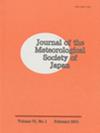化学气候模型模拟的臭氧准两年振荡中臭氧损失路径的划分
IF 1.6
4区 地球科学
Q3 METEOROLOGY & ATMOSPHERIC SCIENCES
引用次数: 3
摘要
利用客观路径分析程序(PAP)对日本气象所开发的化学-气候模式模拟的臭氧准两年周期振荡(QBO)中的臭氧损失路径及其速率进行了评价。所分析的化学体系包含由NOx、HOx、ClOx、Ox和BrOx引起的催化循环。PAP量化了所有重要的催化臭氧损失循环的速率,并评估了这些循环之间的分配。各周期之和的QBO振幅分别约为10 hPa和20 hPa总臭氧损失率年平均值的4%和14%。各循环对臭氧损失率QBO的贡献如下:NOx循环对总臭氧损失率QBO振幅的贡献最大(50 ~ 85%);HOx周期是低于30 hPa的第二大周期(20 - 30%),高于20 hPa的第三大周期(约10%);牛循环在30 hPa以下排名第三(5 - 20%),在20 hPa以上排名第二(约20%);ClOx循环排在第四位(5 - 10%);和BrOx周期几乎可以忽略不计。NOx和Ox循环对臭氧损失QBO振幅的相对贡献与它们对年平均臭氧损失率的贡献分别相差10%和20%。20 hPa的臭氧QBO主要由臭氧输送驱动,臭氧输送改变了臭氧损失率。10 hPa下的臭氧QBO由NOx和[O]/[O3]的温度依赖性驱动,这是由O + O2 + M→O3 + M反应的温度依赖性引起的。此外,10 hPa下的臭氧QBO受架空臭氧柱的影响,通过臭氧光解作用影响[O]/[O3]和臭氧生成速率(通过氧光解作用)。本文章由计算机程序翻译,如有差异,请以英文原文为准。
Partitioning of Ozone Loss Pathways in the Ozone Quasi-biennial Oscillation Simulated by a Chemistry-Climate Model
Ozone loss pathways and their rates in the ozone quasi-biennial oscillation (QBO), which is simulated by a
chemistry-climate model developed by the Meteorological Research Institute of Japan, are evaluated using an ob-
jective pathway analysis program (PAP). The analyzed chemical system contains catalytic cycles caused by NOx ,
HOx , ClOx , Ox , and BrOx . PAP quantified the rates of all significant catalytic ozone loss cycles, and evaluated the
partitioning among these cycles. The QBO amplitude of the sum of all cycles amounts to about 4 and 14 % of
the annual mean of the total ozone loss rate at 10 and 20 hPa, respectively. The contribution of catalytic cycles
to the QBO of the ozone loss rate is found to be as follows: NOx cycles contribute the largest fraction (50 – 85 %)
of the QBO amplitude of the total ozone loss rate; HOx cycles are the second-largest (20 – 30 %) below 30 hPa
and the third-largest (about 10 %) above 20 hPa; Ox cycles rank third (5 – 20 %) below 30 hPa and second (about
20 %) above 20 hPa; ClOx cycles rank fourth (5 – 10 %); and BrOx cycles are almost negligible. The relative
contribution of the NOx and Ox cycles to the QBO amplitude of ozone loss differs by up to 10 % and 20 %,
respectively, from their contribution to the annual mean ozone loss rate. The ozone QBO at 20 hPa is mainly
driven by ozone transport, which then alters the ozone loss rate. In contrast, the ozone QBO at 10 hPa is driven
chemically by NOx and the temperature dependence of [O]/[O3], which results from the temperature dependence
of the reaction O + O2 + M → O3 + M. In addition, the ozone QBO at 10 hPa is influenced by the overhead
ozone column, which affects [O]/[O3] (through ozone photolysis) and the ozone production rate (through oxygen
photolysis).
求助全文
通过发布文献求助,成功后即可免费获取论文全文。
去求助
来源期刊
CiteScore
6.70
自引率
16.10%
发文量
56
审稿时长
3 months
期刊介绍:
JMSJ publishes Articles and Notes and Correspondence that report novel scientific discoveries or technical developments that advance understanding in meteorology and related sciences. The journal’s broad scope includes meteorological observations, modeling, data assimilation, analyses, global and regional climate research, satellite remote sensing, chemistry and transport, and dynamic meteorology including geophysical fluid dynamics. In particular, JMSJ welcomes papers related to Asian monsoons, climate and mesoscale models, and numerical weather forecasts. Insightful and well-structured original Review Articles that describe the advances and challenges in meteorology and related sciences are also welcome.

 求助内容:
求助内容: 应助结果提醒方式:
应助结果提醒方式:


